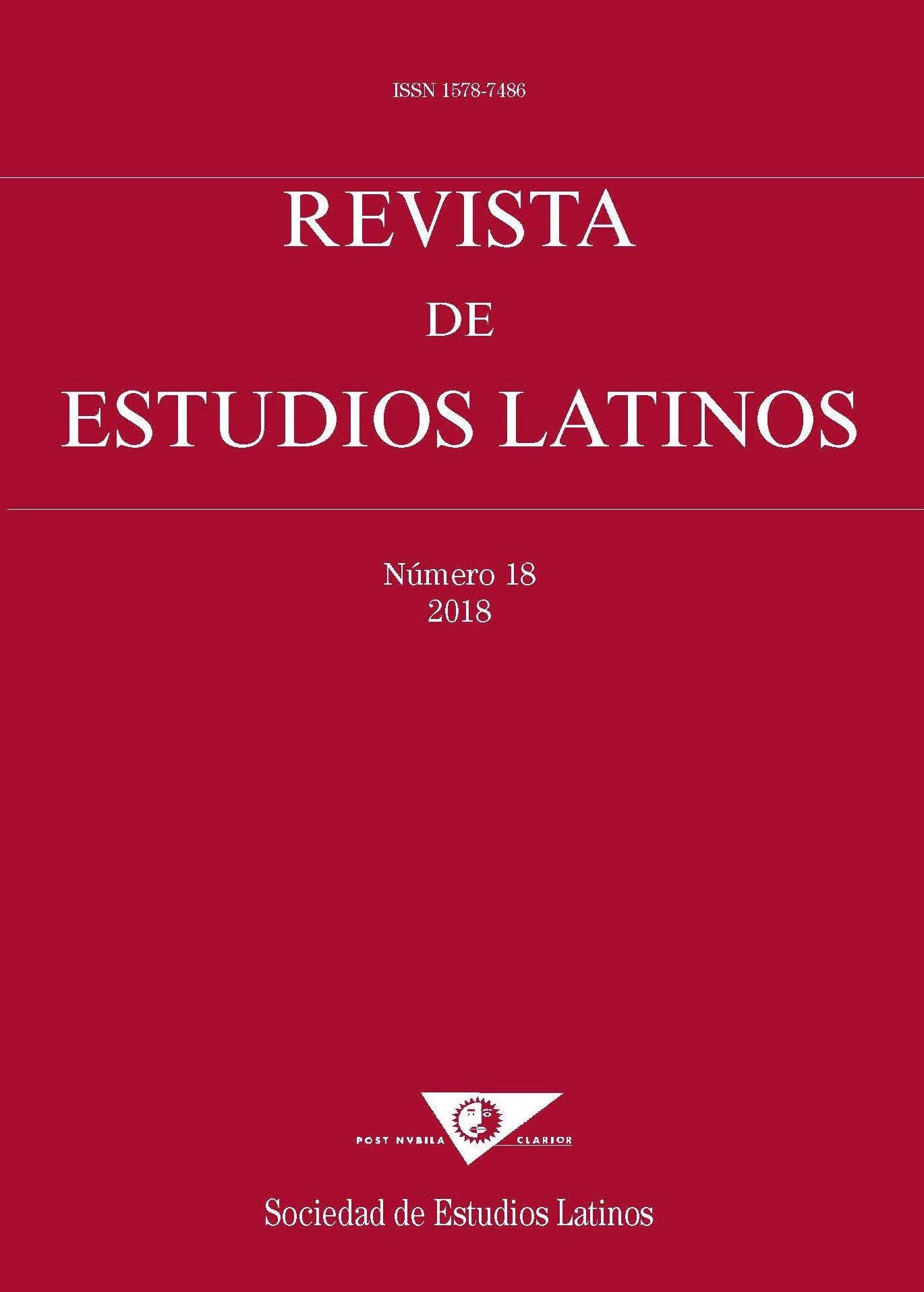Keys to editing De chorographia from El Pinciano’s Retractationes in Pomponium Melam
DOI:
https://doi.org/10.23808/rel.v18i0.82811Keywords:
Pomponius Mela; El Pinciano; textual criticism; commentariesAbstract
The widely accepted view that all other codices of Pomponius Mela’s De chorographia stem from one surviving manuscript (Vat. Lat. 4929) has led to a situation in textual criticism where commentaries on the text, as well as emendations ope ingenii, are of particular importance. The Retractationes in Pomponium Melam by El Pinciano, originally intended as a supplement to his own Castigationes, provide us with further keys to interpret the text, while giving additional information about his method of work and his sources.Downloads
References
Amador, J. (1861): Historia crítica de la literatura española, vol. 1, Madrid, Imprenta de José Rodríguez.
Asís, M. D. de (1974): El comendador griego Hernán Núñez de Guzmán «El Pinciano» en la historia de los estudios clásicos, Salamanca, Universidad de Salamanca.
Asís, M. D. de (1990): «Edición crítica de las Castigationes in Pomponium Melam, de Hernán Núñez», en Noguera, D., Jauralde, P. y Reyes, A. (coords.), La edición de textos: actas del I Congreso Internacional de Hispanistas del Siglo de Oro [Madrid-Córdoba, 1987], Londres, Tamesis Books D. L., 133-139.
Barlow, C. W. (1938): «Codex Vaticanus Latinus 4929», MAAR 15, 87-124.
Baudet, M. L. (trad.) (1843): Géographie de Pomponius Mela, en Seconde série de la Bibliothèque Latine-Française depuis Adrien jusqu’a Grégoire de Tours, París, Panckoucke, C. L. F.
Brodersen, K. (trad.) (1994): Pomponius Mela: Kreuzfahrt durch die alte Welt, Darmstadt, Wissenschaftliche Buchgesellschaft.
Bursian, C. (1869): «Zur Kritik des Pomponius Mela», NJbb 99, 629-655.
Codoñer, C. (2011): «Las Castigationes del Pinciano a Plinio y Pomponio Mela», Aevum 85, 3, 715-749.
Enenkel, K. y Nellen, H. (2013): Neo-Latin commentaries and the management of knowledge in the late Middle Ages and the early modern period (1400-1700), en Supplementa Humanistica Lovaniensia 33, Lovaina, Leuven University Press.
Frick, C. (ed.) (1880): Pomponii Melae De chorographia libri tres, en Bibliotheca Scriptorum Graecorum et Romanorum, Lipsia, Teubner.
Gormley, C. M., Rouse, M. A. y Rouse, R. H. (1984): «The medieval circulation of the De chorographia of Pomponius Mela», MS 46, 266-320.
Guzmán Arias, C. (trad.) (1989): Corografía. De chorographia, Murcia, Universidad de Murcia.
Guzmán Arias, C. (1991): «Pervivencia de las aportaciones del Pinciano al De Chorographia de Pomponio Mela», en Ferreres, L. (ed.), Actes del IXè Simposi de la secció catalana de la SEEC. St. Feliu de Guíxols, 13-16 d’abril de 1988, Barcelona, Universitat de Barcelona Publicacions, 1, 411-419.
Lamb, W. R. M. (intr. y trad.) (1927): Plato. Charmides, Alcibiades I and II, Hipparchus, The lovers, Theages, Minos, Epinomis, en The Loeb Classical Library, Londres y Cambridge-Massachusetts, William Heinemann Ltd. y Harvard University Press (reimp. 1964).
Martin, J. (1727): La religion des Gaulois: tirée des plus pures sources de l’Antiquité, vol. 2, Hijos de Saugrain, París.
Milham, M. E. (1984): «Mela, Pomponius», en Cranz, F. E. (ed.), Catalogus translationum et commentariorum: Mediaeval and Renaissance Latin translations and commentaries, Washington, The Catholic University of America Press, vol. 5, 257-285.
Müller, J. A. (1789-1803): Animaduersiones in Pomponium Melam cum uariis lectionibus codicis Cibiniensis, Mesena y Dresde, Karl Friedrich Wilhelm Erbstein.
Müller, K. (1855-1861): Geographi Graeci Minores, 2 vols., París, Firmin Didot.
Paniagua, D. (2006): El panorama literario técnico-científico en Roma (siglos I-II). «Et docere et delectare», Salamanca, Ediciones Universidad de Salamanca.
Parrasio, A. J. (1567): Liber de rebus per epistolam quaesitis, Ginebra, Enrique Esteban.
Parroni, P. (1981): «Animaduersiones in Pomponium Melam», RFIC 109, 424-432.
Parroni, P. (intr., ed. y com.) (1984): Pomponio Mela: De chorographia libri tres, Roma, Editore di Storia e Letteratura.
Parthey, G. (ed.) (1867): Pomponii Melae De chorographia libri tres, Berlín, F.Nicolai.
Ranstrand, G. (ed.) (1971): Pomponii Melae De chorographia libri tres, en Studia Graeca et Latina Gothoborgensia 28, Gotemburgo, Almqvist & Wiksell.
Reynolds, L. D. (1983): Texts and Transmission, Oxford, Clarendon Press.
Romer, F. E. (intr. y trad.) (1998): Pomponius Mela’s description of the world, Ann Arbor, University of Michigan Press.
Silberman, A. (ed., trad. y notas) (2003, = 1988): Pomponius Mela. Chorographie, París, Les Belles lettres.
Talbert, R. J. A. y Unger, R. W. (2008): Cartography in Antiquity and the Middle Ages. Fresh perspectives, new methods, Leiden y Boston, Brill.
Tauchnitz, C. B. (ed.) (1831): Pomponii Melae de situ orbis libri III, Lipsia, Tauchnitz, C. B.
Tzschucke, C. H. (ed.) (1806-1807): Pomponii Melae de situ orbis: libri tres, ad plurimos codices msstos uel denuo uel primum consultos aliorumque editiones recensiti, 3 vols. (vol. 1; vol. 2 en 3 partes; vol. 3 en 3 partes), Lipsia, Siegfried Lebrecht Crusius.
Downloads
Published
How to Cite
Issue
Section
License
Copyright (c) 2018 Revista de Estudios Latinos

This work is licensed under a Creative Commons Attribution-NonCommercial-NoDerivatives 4.0 International License.
The originals published in the printed and electronic editions of this journal are the property of the Revista de Estudios Latinos and can be circulated as long as the original source and authorship is made clear in any reproduction, full or partial, of the same, and as long as this is not done for commercial purposes.






